| |
|
Xiamen Oil Paintings, Wholesale Direct!
|
|
100% hand painted, 100% cotton canvas, 100% money back if not satisfaction. |
|
|
|
|
ART WORKS INDEX
A
B
C
D
E
F
G
H
I
J
K
L
M
N
O
P
Q
R
S
T
U
V
W
X
Y
Z
|
|
ARTISTS INDEX
A
B
C
D
E
F
G
H
I
J
K
L
M
N
O
P
Q
R
S
T
U
V
W
X
Y
Z
|
|
|
|
|
|
|
|
|
|
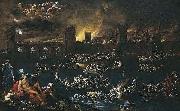 |
Agostino Tassi
|
|
(1578--1644) was an Italian painter, mostly of landscapes and seascapes.
Because he aspired to nobility he modified the details of his early life. Though he was born in Perugia he claimed to have been born in Rome. His family name was Buonamici, but Agostino adopted the surname Tassi to give substance to his story that he was adopted by the Marchese Tassi. He was actually the son of a furrier named Domenico.
|
|
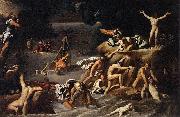 |
Agostino Carracci
|
|
(16 August 1557 ?C 22 March 1602) was an Italian painter and printmaker. He was the brother of the more famous Annibale and cousin of Lodovico Carracci.
He posited the ideal in nature, and was the founder of the competing school to the more gritty (for lack of a better term) view of nature as expressed by Caravaggio. He was one of the founders of the Accademia degli Incamminati along with his brother, Annibale Carracci, and cousin, Ludovico Carracci. The academy helped propel painters of the School of Bologna to prominence.
Agostino Carracci was born in Bologna, and trained at the workshop of the architect Domenico Tibaldi. Starting from 1574 he worked as a reproductive engraver, copying works of 16th century masters such as Federico Barocci, Tintoretto, Antonio Campi, Veronese and Correggio. He also produced some original prints, including two etchings.
He travelled to Venice (1582, 1587?C1589) and Parma (1586?C1587). Together with Annibale and Ludovico he worked in Bologna on the fresco cycles in Palazzo Fava (Histories of Jason and Medea, 1584) and Palazzo Magnani (Histories of Romulus, 1590?C1592). In 1592 he also painted the Communion of St. Jerome, now in the Pinacoteca di Bologna and considered his masterwork. From 1586 is his altarpiece of the Madonna with Child and Saints, in the National Gallery of Parma.
In 1598 Carracci joined his brother Annibale in Rome, to collaborate on the decoration of the Gallery in Palazzo Farnese. From 1598?C1600 is a triple Portrait, now in Naples, an example of genre painting.
In 1600 he was called to Parma by Duke Ranuccio I Farnese to began the decoration of the Palazzo del Giardino, but he died before it was finished.
Agostino's son Antonio Carracci was also a painter, and attempted to compete with his father's Academy.
|
|
 |
Agostino Brunias
|
|
Agostino Brunias (c. 1730 - April 2, 1796) was a London-based Italian painter from Rome. Strongly associated with West Indian art, he left England at the height of his career to chronicle Dominica and the neighboring islands of the West Indies. Painted in the tradition of verite ethnographique, his art was as escapist as it was romantic.
Brunias was born in Rome c. 1730; the exact date is uncertain. His first name has been spelled in various ways including Abraham, Alexander, August, or Austin, while his surname has been recorded as Brunais and Brunyas. Brunias was a student at the Accademia di San Luca, Rome, where he won Third Prize in the Second Class for painting in 1754. An early oil painting of his was exhibited in Rome two years earlier.
|
|
 |
Agnolo Gaddi
|
|
Italian Early Renaissance Painter, ca.1345-1396
|
|
 |
Agnolo Bronzino
|
|
Italian Mannerist Painter, 1503-1572
Agnolo di Cosimo (November 17, 1503 ?C November 23,1572), usually known as Il Bronzino, or Agnolo Bronzino (mistaken attempts also have been made in the past to assert his name was Agnolo Tori and even Angelo (Agnolo) Allori), was an Italian Mannerist painter from Florence. The origin of his nickname, Bronzino is unknown, but could derive from his dark complexion, or from that he gave many of his portrait subjects. It has been claimed by some that he had dark skin as a symptom of Addison disease, a condition which affects the adrenal glands and often causes excessive pigmentation of the skin.
|
|
 |
Agnolo Gaddi
|
|
Italian Early Renaissance Painter, ca.1345-1396
Son of Taddeo Gaddi. Through both his brother Giovanni and his father, Agnolo was heir to the Giottesque tradition and to a successful family enterprise, which he directed with enormous success up to the turn of the 15th century. He is first mentioned as a painter in 1369, when he assisted his brother Giovanni and Giovanni da Milano in decorations for Urban V (reg 1362-70) in the Vatican. Although he probably did not assume full responsibility for the workshop until his brother Giovanni death, he must have begun accepting his own commissions as early as the 1370s. The nature of his early work and whether it included an altarpiece dated 1375 (Parma, G.N., 435), however, remains a matter of debate. Logical or likely though it may be, the notion that this early activity developed out of his brother Giovanni still little-known art is hypothetical. Whereas the works grouped around Giovanni name are all small panels, Agnolo was an artist who, like his father, excelled in wall painting. Indeed, three monumental fresco cycles (see below), in the Castellani Chapel (painted c. 1384) and the choir (painted c. 1388-93) of Santa Croce, Florence, and the chapel of the Sacra Cintola (doc. 1393-5) in Prato Cathedral, constitute the artist most notable surviving works and offer a basis for reconstructing the content and chronology of his oeuvre.
|
|
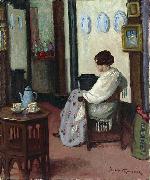 |
Agnes Goodsir
|
|
(18 June 1864, Portland, Victoria - 1939, France) was an Australian portrait painter who moved within lesbian circles in Paris in the 1920s and 1930s.
Goodsir was one of eleven children born to David James Cook Goodsir, Commissioner of Customs at Melbourne, and Elizabeth Archer.
Her early art training started with Arthur T. Woodward at the Bendigo School of Mines in the 1890s, and in 1899 some of her work was raffled in Bendigo to partly finance her study in Paris. The years following World War I saw a virtual exodus of Australian artists on a sort of Grand Tour to Paris, all intent on being part of the explosion of the arts taking place there. Painters like Rupert Bunny, Stella Bowen and Max Meldrum were drawn there by the appeal of the Left Bank. Others like Margaret Preston and Grace Crowley were inspired to develop in new directions by post-war Parisian art.
Goodsir attended the Academie Delecluse, the Academie Julian and then the Academie Colarossi. From about 1912 she shuttled between London and Paris, but finally settled in Paris at 18 Rue de l'Odeon. Her constant companion was Rachel Dunn, depicted in several of her paintings, such as The Chinese Skirt 1933, Girl with Cigarette 1925, The Letter 1926 and Morning Tea 1925.
Her work was acclaimed and exhibited at the New Salon, the Salon des Independants, and the Societe Nationale des Beaux Arts in Paris as well as at the Royal Academy and the Royal Institute in London. On a short visit to Australia in 1927 she exhibited at the Macquarie Galleries in Sydney and the Fine Arts Gallery in Melbourne. In 1938 four of her oils were shown at the sesquicentennial exhibition at the NSW National Art Gallery.
On her death in 1939, her paintings were left to her companion Rachel Dunn, who sent some 40 to Agnes's family in Australia and others to Australian galleries.
|
|
 |
Agasse, Jacques-Laurent
|
|
Swiss Painter, 1767-1849 Specializes in AnimalsEnglish painter of Swiss birth. Born into a wealthy and politically influential Huguenot family, Agasse spent his early childhood at the country estate of Cr?vin, where he may have developed the interest in animals and natural history that was to guide his later career as an artist in England. Agasse trained first at the Ecole du Colibri in Geneva and subsequently in Paris under Jacques-Louis David (beginning in 1787) and possibly under Horace Vernet. His early artistic output consisted chiefly of unpretentious silhouette 'cut-outs' in the style of Jean-Daniel Huber.
|
|
 |
After Peter Paul Rubens
|
|
Sir Peter Paul Rubens (Dutch pronunciation: [ˈrybə(n)s]; 28 June 1577 - 30 May 1640), was a Flemish Baroque painter, and a proponent of an extravagant Baroque style that emphasised movement, colour, and sensuality. He is well-known for his Counter-Reformation altarpieces, portraits, landscapes, and history paintings of mythological and allegorical subjects.
In addition to running a large studio in Antwerp that produced paintings popular with nobility and art collectors throughout Europe, Rubens was a classically educated humanist scholar, art collector, and diplomat who was knighted by both Philip IV, King of Spain, and Charles I, King of England.
|
|
 |
After Jan de Baen
|
|
Jan de Baen (20 February 1633 - 1702) was a Dutch portrait painter who lived during the Dutch Golden Age. He was a pupil of the painter Jacob Adriaensz Backer in Amsterdam from 1645 to 1648. He worked for Charles II of England in his Dutch exile, and from 1660 until his death he lived and worked in The Hague. His portraits were popular in his day, and he painted the most distinguished people of his time.
|
|
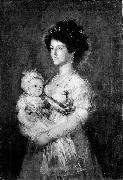 |
After Francisco de Goya
|
|
Francisco Jose de Goya y Lucientes (30 March 1746 - 16 April 1828) was a Spanish romantic painter and printmaker regarded both as the last of the Old Masters and the first of the moderns. Goya was a court painter to the Spanish Crown, and through his works was both a commentator on and chronicler of his era. The subversive and imaginative element in his art, as well as his bold handling of paint, provided a model for the work of later generations of artists, notably Manet, Picasso and Francis Bacon.
|
|
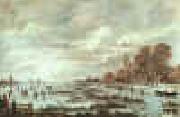 |
Aert van der Neer
|
|
1603-1677
Dutch
Although generally known by the name of Aert, he usually signed himself Aernout. According to Houbraken, van der Neer spent his youth in Arkel near Gorinchem (Gorkum), a town on the river Waal, east of Dordrecht, where he worked as a majoor (steward) for the lords of Arkel. He became an amateur painter, possibly as a result of his contact with the Camphuyzen brothers Rafael Govertsz. (1597/8-1657) and Jochem Govertsz. (1601/2-59). Aert married Lysbeth Govertsdr (Liedtke) who was almost certainly Rafael and Jochem sister. Rafael acted as witness at the baptism of their daughter Cornelia in 1642. Around 1632 van der Neer and his wife moved to Amsterdam where, in about 1634, their eldest son, Eglon, was born.
|
|
 |
Aert de Gelder
|
|
Dutch
1645-1727
Dutch painter and draughtsman. He was the son of a wealthy Dordrecht family and probably became a pupil of Samuel van Hoogstraten in 1660. Apparently on the advice of van Hoogstraten, de Gelder moved to Amsterdam and entered Rembrandt workshop, possibly c. 1661. It is commonly assumed that he stayed there about two years. He was Rembrandt last pupil. After completing his apprenticeship, de Gelder returned to Dordrecht, where he worked for the rest of his long career. Considering that de Gelder was active for more than half a century, his output of just over 100 paintings seems low, probably because he was financially independent. Of those paintings accepted as by him, only 22 are dated, creating considerable problems in establishing a chronology.
|
|
|
|
 |
Aelst, Willem van
|
|
Dutch Baroque Era Painter, 1627-ca.1683 Studied under Otto Marseus van Schrieck. Students included Rachel Ruysch. Specializes in Still Life. was a Dutch artist who specialized in still-life painting with flowers or game. Van Aelst was born to a family of prominent city magistrates. He learned to paint from his uncle, the still-life painter Evert van Aelst. On 9 November 1643 he enrolled as a master of the Guild of Saint Luke at Delft. Between 1645 and 1649 he lived in France. In 1649 Van Aelst travelled to Florence, where he served as court painter to Ferdinand II de Medici, grand duke of Tuscany. At this time, the grand duke also employed two fellow Dutchmen Matthias Withoos and Otto Marseus van Schrieck, the latter also a still-life painter who probably influenced Van Aelst's style. In 1656 he returned to the Netherlands to settle permanently in Amsterdam. He became one of the most prominent still-life painters of his generation,
|
|
 |
Aelbrecht Bouts
|
|
( 1450s, Leuven - March 1549, Leuven) was a Netherlandish painter. His first name is sometimes spelled eAlberte, eAelberte or eAlbrechte. He was born into a family of painters. Aelbrechtes father was Dieric Bouts the Elder (ca.1415-1475), and his brother was Dieric Bouts the Younger (ca.1448-1490). Jan Bouts (ca.1478-ca. 1530), son of Dieric Bouts the Younger, also became a painter. Dieric Bouts the Younger inherited his fatheres shop in 1475, while Aelbrecht established his own workshop, also in Leuven. Whereas Dieric the Younger continued in his father's style, Aelbrecht developed his own unmistakable style with strong colors, rich texture and fine details.
Bob Jones University Museum and Gallery (Greenville, South Carolina), the Cleveland Museum of Art, the Fitzwilliam Museum (Cambridge), Harvard University Art Museums, The Honolulu Academy of Arts, the Hood Museum of Art (Hanover, New Hampshire), the Norton Simon Museum (Pasadena, California), the Royal Museums of Fine Arts of Belgium, the Czartoryski Museum and the Staatsgalerie Stuttgart are among the public collections having paintings by Aelbrecht Bouts.
|
|
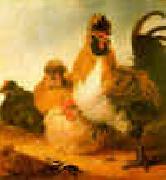 |
Aelbert Cuyp
|
|
1620-1691
Dutch
Aelbert Cuyp Locations
Painter and draughtsman, son of Jacob Cuyp. One of the most important landscape painters of 17th-century Netherlands, he combined a wide range of sources and influences, most notably in the application of lighting effects derived from Italianate painting to typical Dutch subjects. Such traditional themes as townscapes, winter scenes, cattle pieces and equestrian portraits were stylistically transformed and given new grandeur. Aelbert was virtually unknown outside his native town, and his influence in the 17th century was negligible. He became popular in the late 18th century, especially in England.
|
|
|
|
 |
Adrien Lavieille
|
|
(March 29, 1848, Montmartre - February 5, 1920, Chartres) was a French painter.
Portrait of Adrien Lavieille in 1879, by his wife, Marie Adrien Lavieille.
Oil on canvas (private collection).Son of the landscape painter Eugene Lavieille, and nephew of the wood engraver Jacques Adrien Lavieille, he was a painter of the country : near Paris, in Brittany, near Cancale and on the riverside of the Vilaine in the south of Rennes, in Touraine, at Saint-Jean-de-Monts in Vendee, where he was invited by a friend, the painter and engraver Auguste Lepere, around Vendôme where he sojourned in the home of his daughter, Andree Lavieille, so a painter, and of his son-in-law, the man of letters, Paul Tuffrau.
He also painted in Montmartre, where he lived during his youthful days, and, as his father, at Moret-sur-Loing, near Fontainebleau.
Parallelly to his painter's activities, Adrien Lavieille executed, during his life, for money's reasons, works of restoration and decoration : basilica Saint-Martin in Tours (where he worked with the painter Pierre Fritel), Palais de Justice of Rennes, Château de Vaux-le-Vicomte, Hôtel de Lauzun, quai d'Anjou in Paris.
In 1878, he married the painter Marie Petit.
|
|
 |
Adrien Dauzats
|
|
French Academic Painter, 1804-1868,French painter, illustrator and writer. His early training was as a theatrical scene painter and a designer of lithographic illustrations. In Bordeaux he studied with Pierre Lacour (ii) (1778-1859) and worked with Thomas Olivier (1772-1839), chief scene designer at the Grand-Thetre. He subsequently studied in Paris in the studio of the landscape and history painter Julien-Michel Gue (1789-1843) and worked for the decorators of the Thetre Italien.
|
|
|
|
 |
Adrian Vanson
|
|
Adrian Vanson (died c. 1602) was court portrait painter to James VI of Scotland.
Adrian succeeded Arnold Bronckorst as court painter in Scotland in May 1584, and his appointment was subsequently confirmed by royal letter on 20 August 1584. Adrian Vanson was paid £8-10s in June 1581 for two pictures sent to Theodore Beza. A letter by James VI's former tutor Peter Young accompanied pictures of John Knox and George Buchanan sent to Geneva in November 1579 for the woodcuts in Beza's Icones (1580). The Scottish portraits arrived too late for the book, and the woodcuts of Knox and a James VI, thought to be by Vanson, were first published in Simon Goulart's edition of the Icones in 1581. The picture of George Buchanan, which was never published in Beza's Icones, but may have appeared in other later works, is attributed to Bronckorst.
Knox from Beza's Icones,
after Adrian VansonVanson also painted ceremonial spears and banners for the coronation of Anne of Denmark. When he was made a burgess of Edinburgh, it was hoped he would teach his craft to apprentices. He may have been 'Lord Seton's painter', who was recorded drawing portraits for coins at the mint in Edinburgh. There was a un-named Flemish painter working on the king's portrait at Stirling Castle in May 1579. This may have been Vanson or Bronckorst. According to the inventories of the Earl of Leicester, he had a portrait of the 'young king of Scots' in 1580, which may have been another copy of this picture. Leicester sent his own portrait to James VI, painted on canvas by Hubbard in 1583.
Attributed portraits include James VI; Anne of Denmark; Patrick Lyon, Lord Glamis; Sir Thomas Kennedy of Culzean; Agnes Douglas, Countess of Argyll. Vanson's James VI of circa 1585 survives at Edinburgh castle. In May 1586 a French ambassador in Scotland, the Baron d'Esneval, promised to get Mary, Queen of Scots a copy of a recent portrait of James VI from the only painter in Edinburgh. There had been rumours of an embassy to Denmark to discuss the king's marriage in April 1586. It is thought the picture at Edinburgh Castle was made by Vanson for this embassy or a similar purpose.
|
|
 |
Adrian Scott Stokes
|
|
RA (1854-1935) was an English landscape painter. Born in Southport, Lancashire, he became a cotton broker in Liverpool, where his artistic talent was noticed by John Herbert RA, who advised him to submit his drawings to the Royal Academy. He entered the Royal Academy Schools in 1872 and exhibited at the Academy from 1876. In that year went to France where he lived for 10 years, settling back in England in 1886, at Carbis Bay and joining the artists' colony at St Ives.
Adrian Stokes was a landscape painter, concerned most with atmospheric effects, and later with decorative landscapes. He was the author of 'Landscape Painting' (1925). He became ARA in 1909 and RA in 1919, won medals at the Paris Exhibition and Chicago World Fair (1889), became first President of the St Ives Society of Arts (1890) and Vice President of the Royal Watercolour Society (1932).
He married Marianne Preindlesberger of Graz, Austria, in 1884, while living in France. She became a well known artist under her married name of Marianne Stokes. An obituary of Adrian Stokes was published in The Times Monday 2 December 1935
|
|
 |
Adriaen Van Utrecht
|
|
Flemish Baroque Era Painter, 1599-1652
Flemish painter. He was apprenticed to Herman de Ryt in 1614 and later visited France, Italy and Germany before returning to Antwerp by 1625. He painted pantry scenes, farmyards with poultry, fish markets, game pieces, garlands and diverse still-lifes of fruit and vegetables. Game paintings are most frequent and reflect the influence of Frans Snyders. Adriaen adopted the same abundant displays of game, fruit and vegetables, usually set on a table parallel to the picture plane. Compositions typically fall in horizontal and vertical lines in contrast to the dynamic diagonals of Snyders. In large works, such as the Still-life with Game, Vegetables, Fruit and a Cockatoo (1650; Malibu, CA, Getty Mus.), Adriaen's accessories overflow the table on to the floor below. Baroque devices, such as a sweeping curtain and background window view, add movement and depth. Van Utrecht favoured warm earthen tones, especially grey-green, and a strong chiaroscuro light in his still-lifes; the latter may derive from his knowledge of Italian painting. The artist's style changed little during his career, save for the gradual elimination of figures in his paintings. The influence of Jan de Heem and Jan Fyt can also be seen in his later work.
|
|
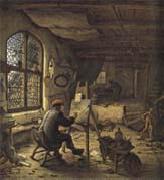 |
Adriaen van ostade
|
|
Dutch Baroque Era Painter, 1610-1685
Painter, draughtsman and etcher. According to Houbraken's rather unreliable biography, he was a pupil concurrently with Adriaen Brouwer of Frans Hals in Haarlem. Hals influenced him very little, whereas Brouwer, who was described as 'known far and wide' as early as 1627, had a decisive influence on the evolution of Adriaen van Ostade's always idiosyncratic portrayal of peasant life. The first documentary mention of Adriaen van Ostade as a painter is in 1632 (Schnackenburg, 1970). Most of his paintings are signed and dated, the earliest firmly dated example being the Peasants Playing Cards
|
|
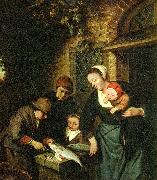 |
adriaen van ostade
|
|
Adriaen van Ostade (baptized as Adriaen Hendricx December 10, 1610 ?C buried May 2, 1685) was a Dutch genre painter.
He was the eldest son of Jan Hendricx Ostade, a weaver from the town of Ostade near Eindhoven. Although Adriaen and his brother Isaack were born in Haarlem, they adopted the name "van Ostade" as painters.
"Peasants in a Tavern" (c. 1635), at the Alte Pinakothek, MunichAccording to Jacobus Houbraken, he was taught from 1627 by Frans Hals, at that time the master of Adriaen Brouwer and Jan Miense Molenaer. At twenty-six he joined a company of the civic guard at Haarlem, and at twenty-eight he married. His wife died in 1640, and he speedily re-married. He again became a widower in 1666. In 1662 he took the highest honors of his profession with the presidency of the painters Guild of Saint Luke in Haarlem. Among the treasures of the Louvre is a striking picture of a father sitting in state, his wife at his side, surrounded by his son, five daughters, and a young married couple in a handsomely furnished room. By an old tradition, Ostade here painted himself and his children in holiday attire; but the style is much too refined for the painter of boors, and Ostade had but one daughter.
|
|
 |
Adriaen Van Diest
|
|
was born at the Hague in 1655. He was the son of Jeronymus van Diest, a painter of sea-pieces, by whom he was instructed in the art. When he was seventeen years of age he came to London, and was employed by Granville, Earl of Bath, for whom he painted several views and ruins in the west of England. He also painted portraits, but did not meet with much encouragement, although his pictures, particularly his landscapes, possess considerable merit; as a proof of which Horace Walpole states that there were seven pictures by Van Diest in Sir Peter Lely's collection. He etched several landscapes from his own designs, in a slight, masterly style. Van Diest died in London in 1704. Unfortunately for his reputation, he is generally known by his worst pictures, which are frequently found in old houses, on wainscots, or over doors, and are executed in a hasty manner, with much mountainous background. His better pictures have changed their name.
|
|
 |
Adriaen van der werff
|
|
Dutch Baroque Era Painter, 1659-1722
Dutch painter and draughtsman. He was apprenticed to the portrait painter Cornelis Picolet (1626-79) from 1668 to 1670 and then from c.1671 to 1676 to Eglon van der Neer in Rotterdam. From 1676 van der Werff produced small portraits and genre paintings as an independent master; the Cook and Hunter at a Window (1678; New York, priv. col.; see Gaethgens, no. 2) and Man and Woman Seated at a Table (1678; St Petersburg, Hermitage) perpetuate the thematic and stylistic traditions of Gerrit Dou, Gabriel Metsu, Frans van Mieris and Gerard ter Borch (ii) but are distinguished by their greater elegance and richness of costume and interior. Van der Werff's portraits date mainly from the years 1680-95 (e.g. Two Children with a Guinea-pig and a Kitten (1681; London, Buckingham Pal., Royal Col.)). The motif of children with animals recalls van der Neer, while the careful depiction of fabrics recalls the Leiden school of 'Fine' painters. His Portrait of a Man in a Quilted Gown (1685; London, N.G.) resembles compositions by Caspar Netscher and Nicolaes Maes: a figure leaning against a balustrade, before a landscape. Van der Werff's work is, however, more elegant, in part because of the depiction of fabrics
|
|
 |
Adriaen van der Spelt
|
|
Adriaen van der Spelt (ca. 1630, Leiden - 1673, Gouda), was a Dutch Golden Age flower painter.
According to Houbraken, whose comments were based on the Gouda stories by Ignatius Walvis, he was an excellent flower painter born in Leiden, but his parentage was from Gouda. He spent many years at the court of Brandenburg working for Frederick William I, Elector of Brandenburg, but moved to Gouda to marry a third time with a nasty wife from Groningen who drove him to his grave.
According to the RKD he was a flower painter who spent the years 1664-1670 at the court of Brandenburg.
|
|
 |
Adriaen van de Venne
|
|
Delft 1589-The Hague 1662
Dutch painter, draughtsman and poet. De Bie's account (1661) is the only known source on van de Venne's youth and training. He was born of 'worthy' parents who had fled to Delft from the southern Netherlands to escape war and religious strife. Inspired by his early study of Latin to become an illustrator, he was partly self-taught but also received instruction in painting and illumination from the otherwise unrecorded Leiden goldsmith and painter Simon de Valck. His second teacher, Hieronymus van Diest,
|
|
 |
Adriaen van de Velde
|
|
(bapt. 30 November 1636, Amsterdam - bur. 21 January 1672, Amsterdam), was a Dutch animal and landscape painter, son of Willem van de Velde the Elder and brother of Willem van de Velde the Younger, the marine painter.
Adriaen did not want to become a marine painter so he was trained in the studio of Jan Wynants, the landscape painter. There he made the acquaintance of Philip Wouwerman, who is believed to have aided him in his studies of animals, and to have exercised a powerful and beneficial influence upon his art. Having made exceptionally rapid progress, he was soon employed by his master to introduce figures into his landscape compositions, and he rendered a similar service to Hobbema, Ruysdael, Verboom and other contemporary artists. According to Houbraken, he died while in collaboration with Jan van der Heyden and Frederik de Moucheron, painting animals on their paintings.[1]
His favourite subjects were scenes of open pasture land, with sheep, cattle and goats, which he executed with dexterity, with much precision of touch and truth of draughtsmanship, and with clear silvery colouring. He painted a few small winter scenes with skaters, and several religious subjects, such as the Descent from the Cross, for a Roman Catholic hidden church in Amsterdam.
In addition to his paintings, of which nearly two hundred have been catalogued, he executed about twenty etchings, several of which appear from their dates to have been done in his fourteenth year. They are distinguished by directness of method and by delicacy and certainty of touch. Van de Velde lived in Kalverstraat, near the Regulierspoort.
|
|
|
|
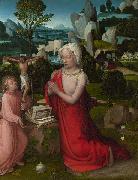 |
Adriaen Isenbrant
|
|
(between 1480 and 1490 - Bruges, July 1551), was a Flemish Northern Renaissance painter, who from documentary evidence was clearly a significant artist of his period, but to whom no specific works can be clearly documented. As hypothesised by art historians, he ran a large workshop specializing in religious subjects and devotional paintings, painting conservatively in the tradition of Early Netherlandish painting. He is believed by some to be the anonymous Master of the Seven Sorrows of the Virgin. Other art historians doubt that any works can be reliably attributed to him, and the number of paintings attributed to him by major museums has been in decline for many decades.
There are only a few documentary records of his life, and some mentions in literature from his lifetime or soon after, but he cannot be documented as the creator of any surviving work; everything else consists of hypothesis. It is possible that he was born in Haarlem or even in Antwerp about 1490. It is not known where or with which painter he served his apprenticeship.
He is named for the first time in 1510, when he came to Bruges and bought his burghership. In November of the same year he already became master in the painterse Guild of St. Luke and the goldsmithse guild of St. Elooi. He was later elected nine time a deacon (in Old Dutch : vinder) and twice the governor (in Old Dutch : gouverneur = treasurer) of the guild.
Soon he had an important workshop, probably in the Korte Vlaminckstraat in Bruges. This was close to the workshop of Gerard David, at the Vlamijncbrugghe and the former workshop of Hans Memling. Bruges, at that time, was one of the richest towns in Europe. Rich traders and merchants ordered diptychs and portraits for personal use. Isenbrandt painted mainly for private clients. However, there were some paintings that were created without any particular commission. He had enough work to even put out work to other painters in Bruges, as a legal suit from 1534 by Isenbrandt against Jan van Eyck (not the famous one) for non-delivery of paintings he had ordered, demonstrates. He was also appointed the agent in Bruges of the painter Adriaan Provoost (son of Jan Provoost), who had moved to Antwerp in 1530. Contemporary sources therefore mention Isenbrandt as a famous and well-to-do painter.
He married twice, the first time with Maria Grandeel, daughter of the painter Peter Grandeel. They had one child. After her death in 1537, he married again in 1547 with Clementine de Haerne. This second marriage resulted in two daughters and a son. He also had an extramarital daughter with the innkeeper Katelijne van Brandenburch (who was at the same the mistress of his friend Ambrosius Benson).
When he died in 1551, he was buried alongside his first wife at the cemetery of the St. Jacob church in Bruges; his children inherited no less than four houses with surrounding property.
|
|
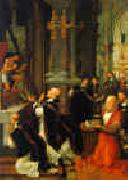 |
Adriaen Isenbrandt
|
|
Flemish Northern Renaissance Painter, ca.1500-1551
There are only a few documentary records of his life, and some mentions in literature from his lifetime or soon after, but he cannot be documented as the creator of any surviving work; everything else consists of hypothesis. It is possible that he was born in Haarlem or even in Antwerp about 1490. It is not known where or with which painter he served his apprenticeship.
He is named for the first time in 1510, when he came to Bruges and bought his burghership. In November of the same year he already became master in the painters?? Guild of St. Luke and the goldsmiths?? guild of St. Elooi. He was later elected nine time a deacon and twice the governor of the guild.
Soon he had an important workshop, probably in the Korte Vlaminckstraat in Bruges. This was close to the workshop of Gerard David, at the Vlamijncbrugghe and the former workshop of Hans Memling. Bruges, at that time, was one of the richest towns in Europe. Rich traders and merchants ordered diptychs and portraits for personal use. Isenbrandt painted mainly for private clients. However, there were some paintings that were created without any particular commission. He had enough work to even put out work to other painters in Bruges, as a legal suit from 1534 by Isenbrandt against Jan van Eyck (not the famous one) for non-delivery of paintings he had ordered, demonstrates. He was also appointed the agent in Bruges of the painter Adriaan Provoost (son of Jan Provoost), who had moved to Antwerp in 1530. Contemporary sources therefore mention Isenbrandt as a famous and well-to-do painter.
He married twice, the first time with Maria Grandeel, daughter of the painter Peter Grandeel. They had one child. After her death in 1537, he married again in 1547 with Clementine de Haerne. This second marriage resulted in two daughters and a son. He also had an extramarital daughter with the innkeeper Katelijne van Brandenburch (who was at the same the mistress of his friend Ambrosius Benson).
When he died in 1551, he was buried alongside his first wife at the cemetery of the St. Jacob church in Bruges; his children inherited no less than four houses with surrounding property.
|
|
 |
Adriaen Hanneman
|
|
(c. 1603 - buried 11 July 1671) was a Dutch Golden Age painter best-known today for his portraits of the exiled British royal court. His style was strongly influenced by his contemporary, Anthony Van Dyck.
|
|
 |
Adriaen Frans Boudewijns
|
|
Adriaan Frans Boudewyns, not Anton Frans (Bauduins, or Baudouin), (3 October 1644 - 3 December 1719) was a Flemish Baroque landscape painter.
He was born at Brussels and learned to paint under a landscape painter named Ignatius van der Stock, and was received into the Guild there in 1665. He then travelled to Paris in 1666 and studied under A. F. van der Meulen for three years, and whose daughter Barbara he married 12 January 1670. In 1674 his wife died and in 1681 he moved back to Brussels where he married again. According to Houbraken he was a good landscape painter who encourage Gerard Hoet to stay in Brussels for 8 months in the 1680s. His son Frans Boudewijns (1682-1767) also became a successful painter. He was ruined in the bombardment of Brussels in 1695.
Adriaen Fransz. Boudewijns, Adriaen Frans Boudewyns, Adriaen Frans Baudewijns, Adriaen Frans Baudewyns, Anton Frans Baudouin, Adriaen Frans Bauduins, Adrien François Bauduins, Monogrammist AFB
|
|
|
|
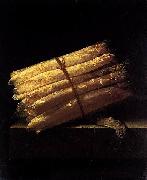 |
Adriaen Coorte
|
|
(ca. 1665 - after 1707) was a Dutch Golden Age painter of still lifes, who signed works between 1683 and 1707. He painted small and unpretentious still lifes in a style more typical of the first half of the century, and was "one of the last practitioners of this intimate category".
Very little is known of his life, but he is assumed to have been born and died in Middelburg. He became a pupil of Melchior d'Hondecoeter around 1680 in Amsterdam. From 1683 he seems to have returned to Middelburg, where he set up a workshop and signed his small, carefully balanced minimalist still lifes. He often painted on paper that was glued to a wooden panel. About 80 signed works by him have been catalogued, and nearly all of them follow the same pattern; small arrangements of fruits, vegetables, or shells on a stone slab, lit from above, with the dark background typical of still lifes earlier in the century. Instead of the Chinese or silver vessels favoured by his contemporaries, his tableware is very basic pottery. "Objects and light are studied intensely, and are painted with a wondrous tenderness".[1] Neither his birth nor death date is certain, and archival evidence only exists in Middelburg for his membership in the Guild of St. Luke there from 1695 onwards, when he was fined for selling a painting without being a member of the guild. His works appear frequently in contemporary Middelburg taxation inventories
|
|
 |
Adriaen Brouwer
|
|
(1605 - January 1638) was a Flemish genre painter active in Flanders and the Dutch Republic in the seventeenth century.
At a young age Brouwer, probably born as Adriaen de Brauwer in Oudenaarde, moved perhaps via Antwerp to Haarlem, where he became a student of Frans Hals alongside Adriaen van Ostade. He also was active in stage acting and poetry. He stayed in Haarlem and Amsterdam until 1631, when he moved back to Antwerp in the Spanish Netherlands. There, he became a member of the Guild of St. Luke in 1631-1632, as well as the rhetoricians's chamber De Violieren.
Tradition has it that Brouwer himself spent much time in the alehouses of Flanders and Holland. His works are typically detailed and small, and often adopt themes of debauchery, drunkenness and foolishness in order to explore human emotions, expressions and responses to pain, fear and the senses. The Bitter Tonic is an example of the type of work that depicts such responses, in this case the sense of taste. His work was well liked, to the point that forgeries were sold in his own time. Both Rubens and Rembrandt owned a number of his works. Nevertheless, Brouwer appeared in financial trouble throughout his life.
He died at the early age of 32 in Antwerp, where he was first buried in a common grave.
|
|
 |
adriaen backer
|
|
the anatomy lesson of dr frederick ruysch,
1670. amsterdams historisch museum
|
|
 |
Adriaan de Lelie
|
|
was born at Tilburg in 1755, and was a scholar of Peeters, a painter of tapestries and ornaments, and afterwards of Quertenmont at Antwerp. He made copies of many of the portraits by Rubens and Van Dyck at Desseldorf, and also of historical pictures by Italian and Dutch masters. By the advice of Professor Camper, he established himself at Amsterdam, where he painted a great number of portraits and cabinet pictures; among the latter is one of the celebrated amateur Jan Gildemeester showing his collection to a party of ladies and gentlemen, in which the principal pictures are readily recognised. One of his best works is that representing the 'Drawing Academy' of the Felix Meritis Society at Amsterdam. His pictures are highly esteemed in Holland and Germany, where they are to be met with in the best collections. He died at Amsterdam in 1820.
|
|
|
|
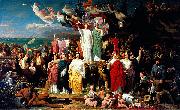 |
Adolphe Yvon
|
|
Adolphe Yvon (1817-1893) was a French painter known for his paintings from the Napoleonic Wars. Yvon studied under Paul Delaroche, rose to fame during the Second Empire, then finished his career as a teacher.
Shortly after the end of the Crimean War in September 1855, Yvon was commissioned by the French government to paint a large picture of the capture of the Malakoff at Sevastopol. He sailed for the Crimea on February 19, 1856 where he spent six weeks compiling a portfolio of sketches, as well as visiting the battlefield of Inkerman. In 1857, the finished painting La Prise de la tour de Malakoff 8 septembre 1855 was shown at the Paris Salon, and two years later came La Gorge de Malakoff, and La courtine de Malakoff. La Prise was a massive piece measuring 6 metres by 9 metres and represented the moment when the fortification was captured around midday.
In the succeeding years, Emperor Napoleon III began to admire his battle scenes; naturally he glorified the carnage of Napoleon I's campaigns. Yvon became an officer of the Legion d'Honneur in 1867, and painted Napoleon III's portrait the following year (unlocated). Yvon was known as the leading teacher of drawing at the Ecole des Beaux-Arts (1863-83). A few Americans received instruction from him, including Christian Schussele, Alfred Wordsworth Thompson, William Sartain, and J. Alden Weir. The latter took Yvon's afternoon life-drawing class starting in the fall of 1874. Yvon provided the subject for compositional sketches for his students, for example, The Assassination of Julius Caesar, for which he specified how it should be done: Caesar covers his head with his toga.
|
|
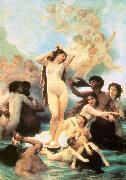 |
Adolphe William Bouguereau
|
|
Bouguereau made more than seven hundred finished works. French painter. From 1838 to 1841 he took drawing lessons from Louis Sage, a pupil of Ingres, while attending the coll?ge at Pons. In 1841 the family moved to Bordeaux where in 1842 his father allowed him to attend the Ecole Municipale de Dessin et de Peinture part-time, under Jean-Paul Alaux. In 1844 he won the first prize for figure painting, which confirmed his desire to become a painter. As there were insufficient family funds to send him straight to Paris he painted portraits of the local gentry from 1845 to 1846 to earn money. In 1846 he enrolled at the Ecole des Beaux-Arts, Paris, in the studio of Francois-Edouard Picot. This was the beginning of the standard academic training of which he became so ardent a defender later in life. Such early works as Equality reveal the technical proficiency he had attained even while still training. In 1850 he was awarded one of the two Premier Grand Prix de Rome for Zenobia Discovered by Shepherds on the Bank of the River Araxes (1850; Paris, Ecole N. Sup. B.-A.). In December 1850 he left for Rome where he remained at the Villa Medici until 1854, working under Victor Schnetz and Jean Alaux (1786-1864). During this period he made an extensive study of Giotto's work at Assisi and Padua and was also impressed by the works of other Renaissance masters and by Classical art. On his return to France he exhibited the Triumph of the Martyr (1853; Luneville, Mus. Luneville; ) at the Salon of 1854. It depicted St Cecilia's body being carried to the catacombs, and its high finish, restrained colour and classical poses were to be constant features of his painting thereafter. All his works were executed in several stages involving an initial oil sketch followed by numerous pencil drawings taken from life. Though he generally restricted himself to classical, religious and genre subjects, he was commissioned by the state to paint Napoleon III Visiting the Flood Victims of Tarascon in 1856
|
|
 |
Adolphe Bouguereau
|
|
French
1825-1905
French painter. From 1838 to 1841 he took drawing lessons from Louis Sage, a pupil of Ingres, while attending the coll?ge at Pons. In 1841 the family moved to Bordeaux where in 1842 his father allowed him to attend the Ecole Municipale de Dessin et de Peinture part-time, under Jean-Paul Alaux. In 1844 he won the first prize for figure painting, which confirmed his desire to become a painter. As there were insufficient family funds to send him straight to Paris he painted portraits of the local gentry from 1845 to 1846 to earn money. In 1846 he enrolled at the Ecole des Beaux-Arts, Paris, in the studio of Fran?ois-Edouard Picot. This was the beginning of the standard academic training of which he became so ardent a defender later in life. Such early works as Equality (1848; priv. col., see 1984-5 exh. cat., p. 141) reveal the technical proficiency he had attained even while still training. In 1850 he was awarded one of the two Premier Grand Prix de Rome for Zenobia Discovered by Shepherds on the Bank of the River Araxes (1850; Paris, Ecole N. Sup. B.-A.). In December 1850 he left for Rome where he remained at the Villa Medici until 1854, working under Victor Schnetz and Jean Alaux (1786-1864). During this period he made an extensive study of Giotto's work at Assisi and Padua and was also impressed by the works of other Renaissance masters and by Classical art. On his return to France he exhibited the Triumph of the Martyr (1853; Lun?ville, Mus. Lun?ville; see fig. 1) at the Salon of 1854. It depicted St Cecilia's body being carried to the catacombs, and its high finish, restrained colour and classical poses were to be constant features of his painting thereafter. All his works were executed in several stages involving an initial oil sketch followed by numerous pencil drawings taken from life.
|
|
 |
Adolph von Menzel
|
|
1815-1905
German
Adolph von Menzel Gallery
His father was the headmaster of a school for girls, and intended to educate his son as a professor; but he would not thwart his taste for art. Left an orphan in 1832, Menzel had to maintain his family. In 1833 Sachse of Berlin published his first work, an album of pen-and-ink drawings reproduced on stone, to illustrate Goethe's little poem, Kunstlers Erdenwallen. He executed lithographs in the same manner to illustrate Denkw??rdigkeiten aus der brandenburgisch-preussischen Geschichte; The Five Senses and The Prayer, as well as diplomas for various corporations and societies.
From 1839 to 1842 he produced 400 drawings, largely introducing to Germany the technique of wood engraving, to illustrate the Geschichte Friedrichs des Grossen (History of Frederick the Great) by Franz Kugler. He subsequently brought out Friedrichs der Grossen Armee in ihrer Uniformirung (The Uniforms of the Army under Frederick the Great), Soldaten Friedrichs der Grossen (The Soldiers of Frederick the Great); and finally, by order of the king Frederick William IV, he illustrated the works of Frederick the Great, Illustrationen zu den Werken Friedricks des Grossen (1843-1849).
By these works Menzel established his claim to be considered one of the first, if not actually the first, of the illustrators of his day in his own line.
Pencil drawing by Menzel, 1891.Meanwhile Menzel had set himself to study unaided the art of painting, and he soon produced a great number and variety of pictures, always showing keen observation and honest workmanship in subjects dealing with the life and achievements of Frederick the Great, and scenes of everyday life, such as In the Tuileries, The Ball Supper, and At Confession. Among the most important of these works are The Forge (1875) and The Market-place at Verona. Invited to paint The Coronation of William I at Koenigsberg, he produced an exact representation of the ceremony without regard to the traditions of official painting.
In Germany he received many honors, and was the first painter to be given the Order of the Black Eagle in 1898 which included a title of nobility, becoming von Menzel.
|
|
|
|
|
|
|
|
|
|
|
| Wholesale China Oil Painting Wholesale Oil Painting China Xiamen Portrait Reproduction on canvas Chinese Oil Painting Wholesale USA Oil Painting |
|
|
|
|
|